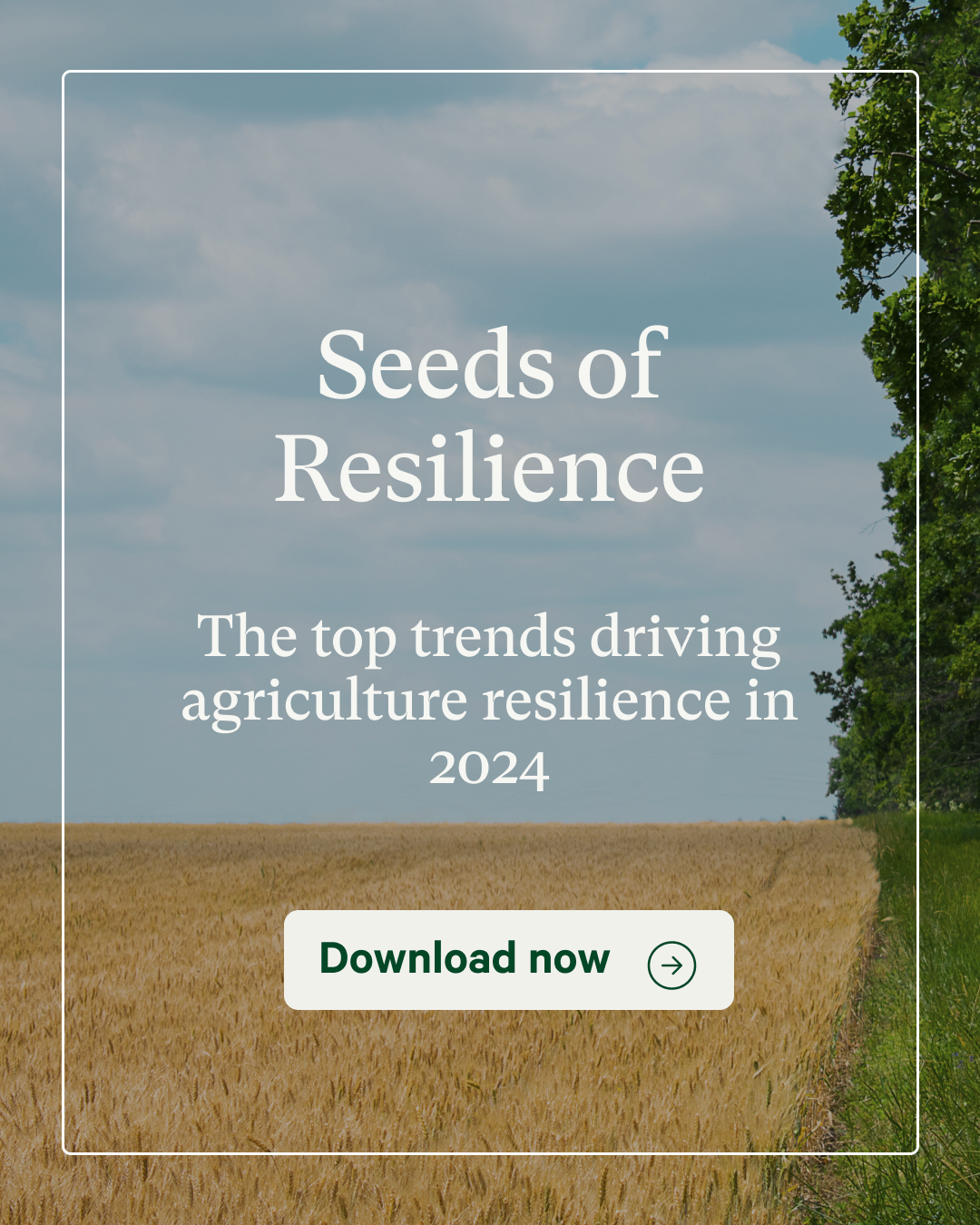2024 stands as a pivotal moment in agriculture.
It's a year in which we expect to see exponential progress in our collective pursuit of agricultural resilience. Our industry has the technology, infrastructure, and capital in place to rapidly scale this holistic approach to agriculture. And we can do it this year.
In this overview, we break down the 4 trends we expect to define 2024, how we can harness those themes to scale and accelerate results, and how we can drive innovation to reach our net zero goals by 2030.

1. Resilience will bridge the gap between sustainability and core business decision-making.
“Climate change is no longer being considered primarily an environmental issue, but a multifaceted source of economic and financial risks that might threaten the stability of the financial ecosystem.” — DTCC
Sustainability remains a priority for businesses today as it has been for years. However, in 2024 we expect sustainability to be more prominently featured in corporations’ core strategies.
This is because companies are increasingly realizing that resilience is a key business objective. As noted by McKinsey & Company in September 2023,
“Many industry leaders expect significant disruption across the agriculture value chain over the next two years, resulting in new opportunities to build and scale green-growth, resilient businesses.”
What exactly is resilience? It’s a holistic risk mitigation strategy. Resilience ensures food supply chains are stable, core ingredients can withstand a changing climate, and agricultural lands are in harmony with the rest of our global ecosystem. A resilient food system supports business stability, ecological stability and geopolitical stability.
Put simply, resilience is the next evolution in your leadership and innovation.
Resilience addresses risk in the following ways:
- Financial risk: agriculture resilience reduces the risks associated with farming (especially in the face of a changing climate) and encourages investment in agricultural activity and ag-based supply chains.
- Environmental risk: emerging standards and regulations require increased reporting around environmental impact and new policies encourage efforts to reduce impact. Agriculture resilience is in alignment with these standards and policies, helping businesses to reduce environmental risk factors.
- Geopolitical risk: Agriculture resilience helps assure supply chain stability, which reduces the risk for conflict, migration and social instability often caused by food insecurity.
2. Companies will pool resources to scale impact. Even competitors.
The agriculture value chain consists of a complex web of stakeholders.
Food is grown by a farmer, with the help of input providers, sold to an aggregator, transported by a trader, refined by a processor, and then ultimately incorporated into the various food products we eat. Decarbonizing this complex supply chain and building a truly resilient system requires collaboration between these stakeholders.
New cross-industry alliances announced at COP28 revealed a welcome willingness for competing brands across the value chain to co-develop plans for emissions reduction.
Cross-industry partnership has also been supported by organizations like the Value Change Initiative (which is developing a method for funding and sharing the benefits of collaborative value chain programs) and pre-competitive frameworks and platforms (which are establishing networks and technologies to encourage collective investment in programs).
We anticipate this momentum will build in 2024, as more alliances are forged and the compounding impact of collaboration are realized.
3. Carbon programs will evolve to more holistic nature-positive programs, incorporating water, biodiversity and other stacked benefits.
In 2024, food and ag companies will increasingly focus on creating positive value chain impact beyond reducing greenhouse gas emissions. We expect to see more investment in biodiversity, water, and ecosystem integrity – impacts that have historically been harder to quantify, but are just as important as reducing greenhouse gas emissions.
The ecosystems that support important natural services (like fertile soils, robust pollinator habitats, and a reliable supply of fresh water) are eroding, largely due to agricultural processes optimized primarily for yield. This can have drastic impacts on land’s ability to produce food or filter water – trends that, compounded, can disrupt supply chains and commodity prices.
Given the probability for supply chain disruption and increased commodity prices, we believe more companies will invest in protecting and rebuilding ecosystems in 2024.
4. Access to more granular data will unlock scaled climate action.
In 2024, companies must begin to actualize their ambitions for scaled climate action. But without data, there will be no action, and most companies lack the precise data needed to make risk-informed decisions on where and how to invest in decarbonizing their supply chain.
Companies have historically relied on generic emissions factors and stock-standard assessments. These generic assessments typically do not capture the location-specific environmental variability needed to turn insights into scaled investment.
We need granular data to reduce the risk of a project.
While other industries may be able to take action informed by more simplified and generic emission factor data, this playbook won’t work for food and ag companies because the majority of these companies’ climate impact is on the farm (and thus, that’s where the biggest investment opportunity lies). With more precise, location-specific data, we are excited to start seeing food and ag companies transition from insights to action in 2024!
Our progress to date has illuminated a path towards resilience — but we are still in the early phases of this journey, and there’s more to be done. Now, it’s our responsibility to embark on this path with rigor, passion and determination, using these trends — resilience, collaboration, co-benefits and comprehensive data — to accelerate our rate of change and help transform our food system.



